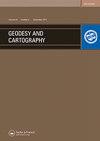航空重力资料解释对agadem石油区块深部构造研究的贡献
IF 2.1
Q3 REMOTE SENSING
引用次数: 0
摘要
重力图提供的主要信息是地下密度非均质性的地理分布。它是一种重要的工具,广泛用于地质构造的填图,特别是在石油工业中。因此,本研究在航空重力资料解释的基础上,客观、定性地描述了研究区重力异常特征,并对重力线状体及其深度进行了解释和填图,认识到这些线状体构成了有利于油气聚集的潜在构造圈闭。利用水平导数、向上延拓和欧拉反褶积等方法,对不同的异常进行地质分析,突出深部构造。因此,残差异常图分析显示,负异常带和正异常带呈细长状,全球向北西-东西,分别被认为是地堑带和地堑带。重力线被认为是正断层,用水平梯度法绘制。最后,通过欧拉反褶积计算,以“1”值作为结构指标,估计密度对比的深度。这样确定的深度变化很大。最浅的深度在3000 ~ 6000米之间,最深的深度可达18000米。本文章由计算机程序翻译,如有差异,请以英文原文为准。
CONTRIBUTION OF AEROGRAVITY DATA INTERPRETATION TO THE STUDY OF THE DEEP STRUCTURE OF AGADEM PETROLEUM BLOCK (NIGER)
The main information provided by gravity maps is the geographical distribution of density heterogeneities in the subsurface. It is an important tool widely used for the mapping of geological structures, especially in the oil industry. Thus, this study based on the interpretation of aerogravity data has for objective, the qualitative description of the characteristics of the gravity anomalies of the study area, interpretation and mapping of the gravity lineaments as well as their depths, knowing that the lineaments constitute potential structural traps favorable to the accumulation of the hydrocarbons. Methods such as horizontal derivative, upward continuation and Euler deconvolution are used to give a geological signifiance to the different anomalies and to highlight deep structures. Thus, the analysis of the residual anomaly map revealed elongated negative and positive anomaly zones, oriented globally NW-SE, considered respectively as horst and graben zones. Gravity lineaments, considered as normal faults, are mapped using the horizontal gradient method. Finally, the depths of the density contrasts are estimated by the Euler deconvolution calculation using the value “1” as structural index. The depths thus determined are highly variable. The shallowest depths vary between 3000 m and 6000 m, while the deepest depths reach 18000 m.
求助全文
通过发布文献求助,成功后即可免费获取论文全文。
去求助
来源期刊

Geodesy and Cartography
REMOTE SENSING-
CiteScore
1.50
自引率
0.00%
发文量
0
审稿时长
15 weeks
期刊介绍:
THE JOURNAL IS DESIGNED FOR PUBLISHING PAPERS CONCERNING THE FOLLOWING FIELDS OF RESEARCH: •study, establishment and improvement of the geodesy and mapping technologies, •establishing and improving the geodetic networks, •theoretical and practical principles of developing standards for geodetic measurements, •mathematical treatment of the geodetic and photogrammetric measurements, •controlling and application of the permanent GPS stations, •study and measurements of Earth’s figure and parameters of the gravity field, •study and development the geoid models,
 求助内容:
求助内容: 应助结果提醒方式:
应助结果提醒方式:


